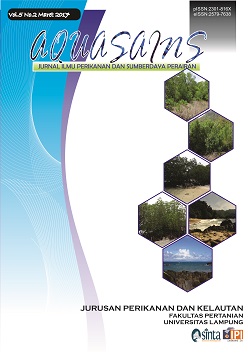DEPOSIT STRUCTURE CHARACTER CaCO ON THE SHELLS OF SCALLOP (Amusium pleuronectes) AS BIO-INDICATORS OF ENVIRONMENTAL CONDITIONS IN THE BATANG WATERS
Abstract
The objectives are :(1) Measurement of the character structure of CaCO3 deposit on simping’sshells, (2) Identifying Environmental Conditions of simping in Batang. The study will be conducted exploratory descriptive method (non-experimental). The results showed as morphometric’s measurement, there’s no difference in the population growth of simping in Batang from 2003 to current. Based of analysis of the hue-saturation value which is the phenotype of CaCO3 biomineralization mechanism that is deposited in the shell, showed that the biological potency (early-stage) of the character of the population’s simping growth in Batang is better than the Brebes’s population as a comparison. Conditions of natural habitat in Brebes relatively better, so that CaCO3 deposits is better also.Based on those results, efforts to provide science and technology inputs to support the preservation of aquaculture activities is to engineer a better environment to support the genetic potential to convert to a more optimum growth rate. Another thing that can do is to optimize the genetic potential of Batang’s simping as selective-breeding material in marine culture. It is expected that these strategies can be used to overcome the problem of limited production scallop in northern coast of Central Java in order to meet the needs of the market potential through mariculture activities.
Downloads
Downloads
Published
How to Cite
Issue
Section
License
License for Authors
Authors who publish with this journal agree to the following terms:
- Authors retain copyright and grant the journal right of first publication with the work simultaneously licensed under a Creative Commons Attribution License that allows others to share the work with an acknowledgement of the work's authorship and initial publication in this journal.
- Authors are able to enter into separate, additional contractual arrangements for the non-exclusive distribution of the journal's published version of the work (e.g., post it to an institutional repository or publish it in a book), with an acknowledgement of its initial publication in this journal.
- When the article is accepted for publication, its copyright is transferred to Aquasains Journal. The copyright transfer convers the exclusive right to reproduce and distribute the article, including offprint, translation, photographic reproduction, microfilm, electronic material, (offline or online) or any other reproduction of similar nature.
- Authors are permitted and encouraged to post their work online (e.g., in institutional repositories or on their website) prior to and during the submission process, as it can lead to productive exchanges, as well as earlier and greater citation of published work (See The Effect of Open Access).
- The Author warrant that this article is original and that the author has full power to publish. The author sign for and accepts responsibility for releasing this material on behalf os any and all-author. If the article based on or part os student’s thesis, the student needs to sign as his/her agreement that his/her works is going published.
License for Regular Users
Other regular users who want to cite, distribute, remix, tweak, and build upon author’s works, even for commercial purposes, should acknowledge the work’s authorship and initial publication in this journal, licensed under a Creative Commons Attribution License.
This license lets others distribute, remix, tweak, and build upon your work, even commercially, as long as they credit you for the original creation.
This work is licensed under a Creative Commons Attribution 4.0 International License.Copyright Transfer Statement can be downloaded here


.png)









